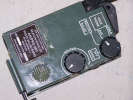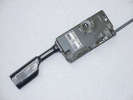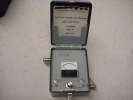|
All American SAR- Radios from their beginning to 1968 are part of the collection.
More modern ones are (still) too expensive....
American SAR-Radios
You may also read the article by Alan Tasker :
"U.S. Military Portable Radios"
PRC-90 (1968)
is an American SAR Radio,
developed by the Navy,
and used by all forces.
It is switched on manually at bailout and not automatically (as e.g. URT-33).
It is used as radio and beacon on 243 MHz (the military distress channel).
On 282,2 MHz it is a radio only. 282.2 is used by civil air patrol for communication with military SAR aircraft.
PRC-103, PRC-106 und PRC-125 are derivates of PRC-90.
Its producer was Sylvania. You can notice a great resemblance to the Israel PRC-601 / 4. (Click picture).
There are indeed some hints that Sylvania helped to construct this, too.
"One thing to notice is the use of magnets and reed switches. The
main selector switch has a magnet inside, and actuates one of three reed switches (or
none when in the off position) inside for the three main selections. The earphone has
a magnet inside the connector, so that the speaker will be shut off when the earphone
is used." (Alan Tasker)
 [click] About the development of the PRC-90, by Alan Tasker, WA1NYR:
[click] About the development of the PRC-90, by Alan Tasker, WA1NYR:
AN/PRC-90 was the first model.
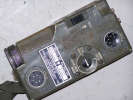 |
[ < click ]
|
The PRC-90 was followed by many variants. The collection shows:
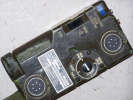 |
AN/PRC-90-1
[ < click ]
|
The same frequencies as the PRC-90. MCW- function was removed and replaced by a beacon- function.
The lettering was simply painted over.
 |
AN/PRC-90-A
[ < click ]
|
Navy- version in grey paint .Same data as the PRC-90.
 |
AN/PRC-90T
( T = Training )
[ < click ]
|
236.0 MHz: Voice RX / TX; 251.9 MHz: RX
is the Training version of PRC-90.
Training radios have a totally different color so that they cannot be changed by mistake.
They use training- frequencies, and the beacon- function is disabled.
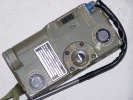 |
AN/PRC-90-2
[ < click ]
|
Differencies to the AN/PRC-90-1:
MCW- funktion is removed
Beacon- funktion engraved
Half wave antenna without external matching unit (spares costs)
Microphone and earphone are set deeper into the housing.
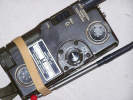 |
AN-PRC-106
[ < click ]
|
121.5 and 243.0 MHz: Speech RX /TX and beacon
Beacon- function removed from the frequency switch. However it can be used on each frequency by pushing
a button on the upper side of the housing.
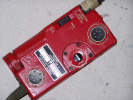 |
AN-PRC-106T
( T = Training )
[ < click ]
|
(Here the red training version) has 115.7 Mhz and 251.9 MHz without beacon- function.
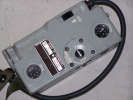 |
AN-PRC-111
[ < click ]
|
|









